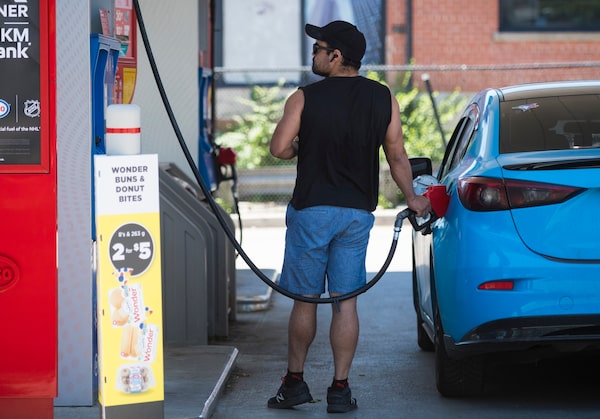
A commuter pumps gas into their vehicle at a Esso gas station in Toronto on June 15, 2021.Tijana Martin/The Canadian Press
It’s hard to see the future on death row. It’s easier to look back and ponder what might have been.
The postmortem consensus after the last two federal elections was that the Conservative Party fell short in part owing to its lack of a credible climate plan. That was just a few years ago. These days, Conservative Leader Pierre Poilievre never misses an opportunity to say “Axe the tax.” It’s an applause line. He’d stop saying it if it wasn’t.
Eight provincial premiers also want out of federally imposed carbon pricing. Most are conservatives, but among the carbon-tax skeptics is Manitoba’s New Democratic Premier Wab Kinew. He even brought in a six-month provincial gas-tax holiday, since extended to nine months. Do not be surprised if Mr. Kinew extends it again. That’s what Ontario Premier Doug Ford keeps doing: His 2022 “temporary” cut to the provincial fuel tax gets reannounced every few months.
This is not how we residents of Eggheadville expected things to turn out. We thought that a steadily rising levy on carbon-based fuels such as gasoline and diesel, rebated back to citizens on a per capita basis, would be a winner not just for the environment and the economy, but with voters. Instead of an inefficient, opaque and centralized system for reducing carbon emissions, Canada would put a price on carbon and leave it to folks to figure out how to best reduce their personal carbon tax costs, and thus their emissions. The market. Freedom. Autonomy. Yada, yada.
And again, the funds would go back to citizens. If you consumed less than the average amount of carbon, you’d end up making money off what is officially called the federal “fuel charge.” Most lower- and middle-income people would come out ahead.
But we in the egghead fraternity failed to consider that, as with the introduction of the GST, the visibility of the carbon tax, which is its chief economic and environmental virtue, might become its chief political defect.
We also failed to anticipate that the Trudeau government would somehow never figure out how to explain the whole money-back part of the equation. Canadians in the eight affected provinces appear to be only vaguely aware that hundreds of dollars are being regularly deposited into their bank accounts.
Meanwhile, Quebec’s cap-and-trade carbon system – same costs as a carbon tax, but in a black box, and with not a cent rebated to taxpayers – is a political non-issue.
All of which points to two possible futures. And probably a bit of both.
One possibility is that what comes next is not just the end of the consumer carbon levy, but the start of a wider push to lower the price of gas and other carbon fuels, by cutting levies such as the long-standing 10-cents-a-litre federal excise tax.
Earlier this month, Mr. Poilievre called for a gas-tax holiday, and it’s not hard to see why. Right now, a politician promising to make gas cheaper gets better mileage than one pledging to make it more expensive.
But aside from the obvious environmental question – do we really want to make operating gas-powered cars and natural gas furnaces cheaper, relative to electric vehicles and heat pumps? – this “affordability” policy is not free.
A family of four in Ontario gets $1,120 in carbon tax rebates this year. If they’re rural, $1,344. In Alberta, the amounts are $1,800 and $2,160. Eight out of 10 households get back more than they pay. If the tax and its rebate both disappear, a working-class family in Toronto that lives in an apartment and doesn’t own a car is going to find a rather large hole in its budget. Which is why “Axe the tax” is Mr. Poilievre’s slogan, not “Axe the tax rebates.”
Cutting other levies on gasoline and diesel raises the same issue.
Manitoba’s gas tax brings in $340-million a year – or 1.5 per cent of provincial revenues. Ontario’s gas-tax holiday costs $620-million every six months. These tax breaks are affordability measures for some, but unaffordability measures for others. They mean less money for everything from health care to public transit to homeless shelters to deficit reduction.
The other possible postcarbon tax future, however, is one where the in-your-face, at-the-pump carbon tax gets visibly axed – but the hidden and much larger system for charging industrial emitters remains.
That may be the most likely outcome. Deep blue Alberta and Ontario have industrial carbon pricing systems that are aligned with the federal standard, and that are quietly getting the job done. They don’t appear to have any plans to end them.